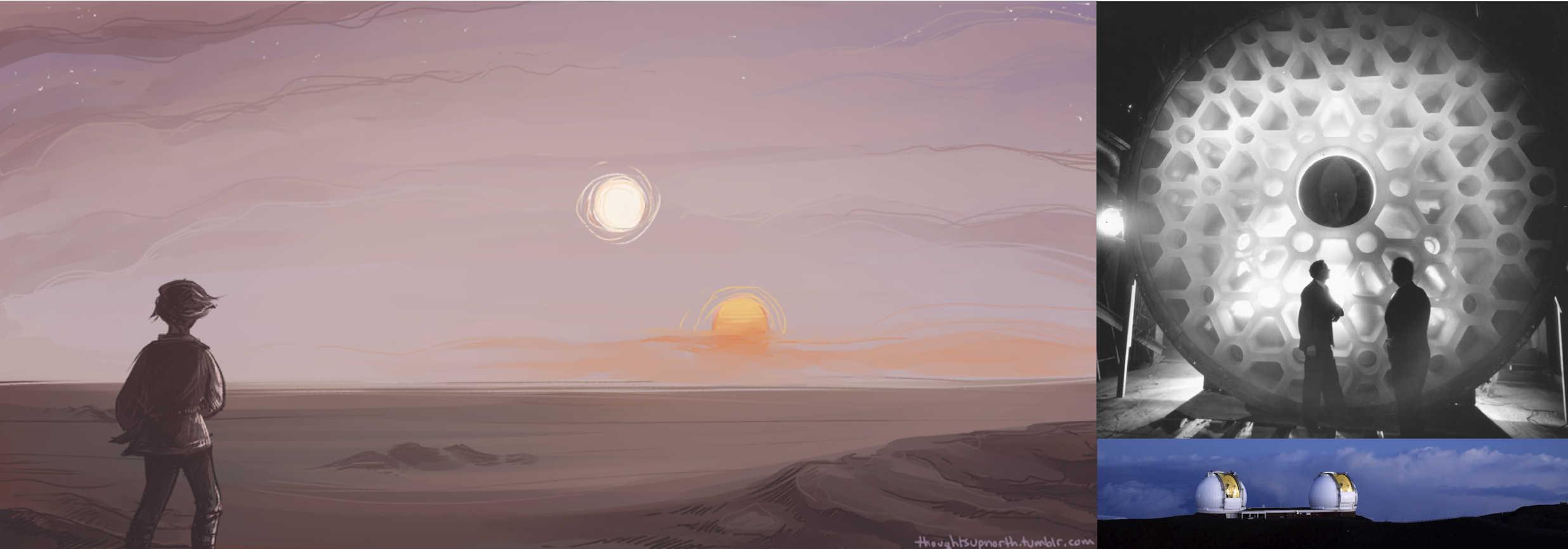Planets in Binary Stars - A Dream of Tatooine

Project Description
Binary stars are prevalent. Looking up to the night sky, one third of stars have two stellar components. Most of the time, one cannot see both components because they are too close to each other and human eyes do not have enough resolution to separate them. Since one third of stars are binary stars, as an exoplanetary scientist, I cannot help asking the question: how often do planet form in binary stars? I am not the first to ask the question. In fact, many studies have been done on this topic, both theoretical and observational. However, a quantitative answer is missing on how planets form differently in binary stars from planets around single stars.
Inspired by Tatooine in the Star Wars, a planet orbiting around a pair of stars, I attack the problem using some of the biggest telescopes in the world, the Palomar 200-inch Hale telescope and the Keck telescopes. One thing to be noted is that the planets in binary stars I am studying are different from the Tatooine. Instead of orbiting both stars, the planets of my interest are orbiting only one component of the binary stars. In such configuration, planet formation is expected to have several difficulties. These difficulties are caused by a companion star in the same system. The companion star could truncate the protoplanetary disk where planets form. The companion star could also perturb the materials in the disk such that destructive collision outnumbers constructive collision. Even after planets form, the companion star could potentially eject some of the planets. Against all odds, planets do form in binary stars.
My studies offer a quantitative comparison between the occurrence rate of planets in binary stars and planets around single stars. Combining the radial velocity data and high angular resolution imaging observations at Palomar and Keck. I find that, despite overcoming difficulties of planet formation, planets in binary stars are rarer than those around single stars. How rare it is depends on the separation of the companion star. For example, if the companion star is only 10 AU away, i.e., 10 times the distance between the Earth and the Sun, the odds of forming a planet is only 20% compared to a single star case. However, if the separation is more than 1500 AU, i.e., 10 times the distance of Voyager 1, planet formation is barely influenced by the companion star.
My findings indicate that planet formation is suppressed in binary stars. For future mission in the search for Earth-like planets, it is a good strategy to avoid binary stars to maximize the planet yield. For Tatooine fans, do not lose hope yet. Tatooine may still exist in reality, a study has shown that circumbinary planets, i.e., planet orbiting both stars, may be common.
Selected Press Coverages
Yale Scientific Magazine: So Many Stars...So Many Planets? The Prospects of Planet Formation in Multi-Stellar Systems

Publications
Ji Wang, Debra A. Fischer, Ji-Wei Xie, David R. Ciardi. Influence of Stellar Multiplicity on Planet Formation. IV. Adaptive Optics Imaging of Kepler Stars with Multiple Transiting Planet Candidates. 2015, ApJ, 813, 130
Ji Wang, Debra A. Fischer, Elliott. P. Horch, Ji-Wei Xie. Influence of Stellar Multiplicity on Planet Formation. III. Adaptive Optics Imaging of Kepler Stars With Gas Giant Planets. 2015, ApJ, 806, 248 Physical Association Probability Calculator
Ji Wang, Debra A. Fischer, Ji-Wei Xie, David R. Ciardi. Influence of Stellar Multiplicity on Planet Formation. II. Planets are Less Common in Multiple-star Systems with Separations Smaller than 1500 AU. 2014, ApJ, 791, 111
Ji Wang, Ji-Wei Xie, Thomas Barclay, Debra Fischer. Influence of Stellar Multiplicity on Planet Formation. I. Evidence of Suppressed Planet Formation due to Stellar Companions within 20 AU and Validation of Four Planets from the Kepler Multiple Planet Candidates. 2014, ApJ, 783, 4